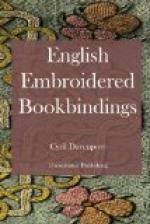As regards book-illustration the same claim may be put forward, though with a little more hesitation. We have been taught lately, with insistence, that ‘the sixties’ marked an epoch in English art, solely from the black and white work in illustrated books. At that period our book-pictures are said to have been the best in the world; unfortunately our book-decoration, whether better or worse than that of other countries, was almost unmitigatedly bad. In the last quarter of a century our decorative work has improved in the most striking manner; our illustrations, if judged merely for their pictorial qualities, have not advanced. In the eyes of artists the sketches for book-work now being produced in other countries are probably as good as our own. But an illustration is not merely a picture, it is a picture to be placed in a certain position in a printed book, and in due relation to the size of the page and the character of the type. English book-illustrators by no means always realise this distinction, yet there is on the whole a greater feeling for these proprieties in English books than in those of other countries, and this is an important point in estimating merits. Another important point is that the rule of the ‘tint’ or ‘half-tone’ block, with its inevitable accompaniment of loaded paper, ugly to the eye and heavy in the hand, though it has seriously damaged English illustrated work, has not yet gained the predominance it has in other countries. Our best illustrated books are printed from line-blocks, and there are even signs of a possible revival of artistic wood-engraving.
In endeavouring to make good my assertion of what I have called the occasional primacy of English book-work, I am not unaware of the danger of trying, or seeming to try, to play the strains of ‘Rule Britannia’ on my own poor penny whistle. As regards manuscripts, therefore, it is a pleasure to be able to seek shelter behind the authority of Sir Edward Maunde Thompson, whose words in this connection carry all the more weight, because he has shown himself a severe critic of the claims which have been put forward on behalf of several fine manuscripts to be regarded as English. In the closing paragraphs of his monograph on English Illuminated Manuscripts he thus sums up the pretensions of the English school:—




